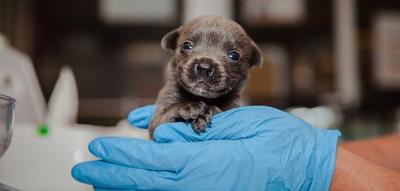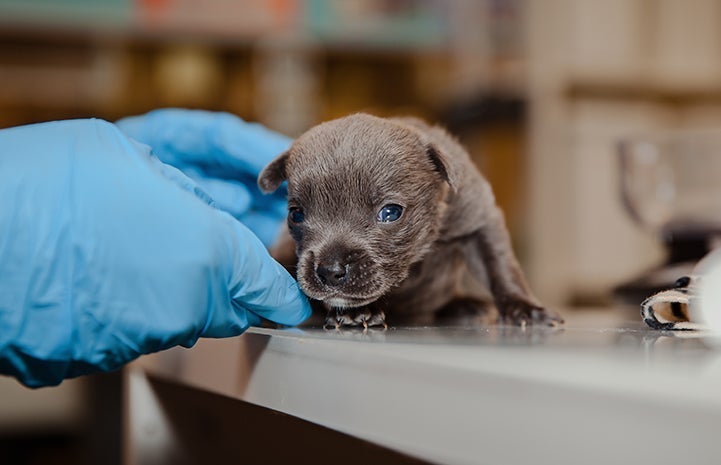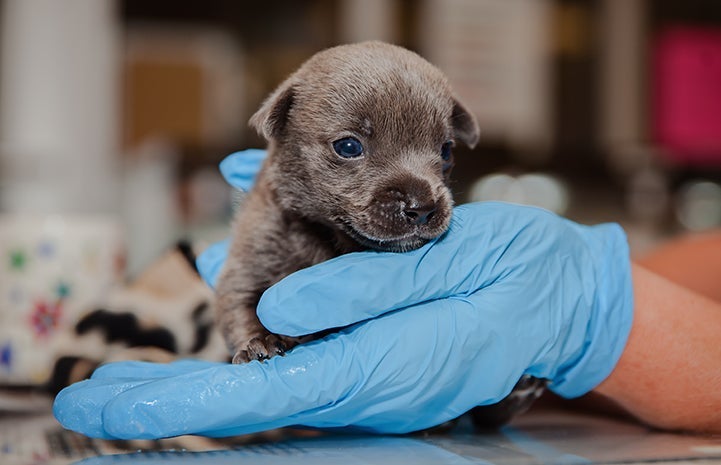
Caring for Orphaned Newborn Puppies: Feeding, Socializing, and More
Raising orphaned newborn puppies can be very rewarding. It is, however, a serious responsibility that requires time, effort, and money on your part if you want to help the little ones grow up healthy and happy. Close observation and prompt attention if any problems develop are especially important. If you have not raised newborn puppies before, you should have a veterinarian examine the pups before you get started. And don’t be disappointed if you are unable to save all the orphaned puppies; you can only give it your best effort.
Here is some general information to know about caring for orphaned newborn puppies, including their basic medical needs, bottle-feeding puppies, socialization, and more.
Setting up a space for newborn puppies
If the puppies were being cared for by their mother, she would choose a place that is soft, warm, and away from full sunlight. In the absence of their mother, you must provide this type of environment.
A box might be large enough for a first home for the family. Put the box in a warm, sheltered space. If the litter is a big one, you might need to buy a kiddie pool or something similar to contain the pups. As the puppies grow, watch to see whether they can climb out of the box or pool. Once puppies start to move, they can climb well within a surprisingly short period of time.
Bedding
For bedding, use clean packing paper or newspaper layered on top of a flat towel for the first week or so. Newborn puppies can get caught up in soft cloth and can die if they can’t breathe. After they are able to lift their heads and move around a bit, you can use a towel, sheet, or blanket. When the puppies start crawling, and then walking, they’ll use the cloth for traction.
Warmth
A puppy burns far more body heat per pound of body weight than an adult dog. To stay warm, puppies depend on radiant heat from their mother. In her absence, they need constant temperature control. So you’ll have to provide your puppies with a draft-free nesting area. Heat lamps or hot water bottles can be used to keep the temperature controlled.
During the first four or five days of life, puppies should be kept in an environment that is between 85 and 90 degrees Fahrenheit. The temperature can gradually be decreased to 80 degrees by the seventh to 10th day and can be reduced to 70 to 75 degrees Fahrenheit by the end of the fourth week.
Provide necessary warmth or cooling to the puppies gradually. If you have a large litter, they will huddle together, which means they won’t require as much help with external heat from you. Take care not to overheat the puppies; newborn puppies cannot move away from the heat on their own.
Disease prevention and visitors
Puppies are very vulnerable to disease, so disease prevention in their space is important. Always wash your hands before touching the puppies. If you work with other animals or visit animal shelters or dog parks (anyplace where you come in contact with other dogs), always change your clothes and shoes before entering the area where the puppies are kept and before handling the puppies.
Likewise, limit the number of visitors to the puppies' space and the number of people who handle the pups until they are at least a few weeks old. Avoid interaction if someone has been in contact with sick animals or has been to an animal shelter, vet's office, or other animal facility just before visiting.
Basic newborn puppy medical needs
What should you know about newborn puppies and their medical needs? Here’s some basic information about what’s normal and what’s not.
Temperature
A normal rectal temperature for a newborn puppy is 95 to 99 degrees Fahrenheit for the first week and 97 to 100 degrees Fahrenheit for the second week. By the fourth week, the puppy’s temperature should reach the normal temperature of an adult dog: 100 to 102 degrees Fahrenheit. Puppies under about 38 days old have a reduced ability to regulate their body temperature and will need a temperature-controlled environment.
Weight
Weighing the puppies daily to check for weight gain can reassure you that they are doing well. If a puppy is failing to gain weight or is losing weight, you should consult with your veterinarian.
Vision
Puppies’ eyes open when they are 10 to 14 days old. Because their eyes are very sensitive to light, they should be kept out of direct sunlight until approximately 4 weeks old.
Home starts with you
Hearing
The ear canals of puppies open between 5 and 8 days old.
Stimulating puppies for elimination
For the first two weeks of life, puppies are stimulated by their mother to encourage urination and defecation. In the absence of their mother, you will have to provide the stimulation. Massage your puppies’ genital area with a moist cloth to stimulate bladder and bowel action. After two weeks, puppies should urinate and defecate on their own. Watch them carefully to make sure that happens.
Diarrhea
Diarrhea is common in puppies and can be caused by parasites, viruses, bacteria, food changes (e.g., formula that is too concentrated, a new brand of formula), stress, overfeeding, and other reasons. If the diarrhea is mild and the puppy is otherwise alert and vigorous, you can try giving less food more often and monitor the pup closely.
Also, make sure that the puppy gets a lot of fluid, as they are prone to dehydration if they don’t get enough. This can be done by diluting the formula with extra water or giving the puppy clean warm water in a bottle or syringe. If the diarrhea is severe, lasts more than three or four feedings, or contains blood or obvious parasites, you should call a veterinarian (and bring a sample of feces to the vet).
Dehydration
The lack of normal parental care might mean that you receive orphaned puppies who are dehydrated. They might also become dehydrated from other causes, such as diarrhea, vomiting, or by being chilled. Newborn puppies can’t nurse if they are too cold because their energy is spent trying to stay warm.
One sign of dehydration is loss of elasticity in the skin. If you pick up the pup’s scruff with two fingers, it will stay up, looking pinched. Another way to test for dehydration is to look at the puppy’s gums (mucous membranes). The gums should be moist and shiny; if you touch them, they should not be sticky.
Hypoglycemia
Hypoglycemia, an abnormal decrease of sugar in the blood, can also happen to orphaned puppies. The signs to look for are lack of strength, lethargy (lack of movement), and muscle twitching (sometimes with convulsions). If a puppy shows signs of hypoglycemia, place a few drops of corn syrup under their tongue and on the gums, and call your veterinarian immediately for further assistance.
Internal parasites
If a puppy is developing very slowly, has an extremely large bloated belly, or has blood in their stool, they might have internal parasites. A stool sample should be taken to your veterinarian for examination.
Nail trimming
The puppies will need nail trims often. If you have not trimmed toenails on dogs, ask someone to show you how to do it safely. Human nail clippers work well on small puppies.

Bottle-feeding orphaned puppies
Newborn puppies will need food every two to three hours around the clock. Six or eight meals, equally spaced over 24 hours, are sufficient for most puppies; small or weak puppies might need more feedings.
You can give your orphaned puppies complete nutrition by buying a commercial puppy milk replacer (such as Esbilac), which can be purchased through your veterinarian or a pet supply store. Commercial milk replacers have feeding directions on the label and should be given at the puppy's body temperature (about 100 degrees Fahrenheit). Once the can is opened or the powder reconstituted, unused formula should be kept refrigerated and discarded after 24 hours. When the puppies are 3 to 4 weeks old, you can start feeding them milk replacer at room temperature.
When feeding orphaned puppies, it’s best to use commercial animal baby bottles; you can use an eyedropper in an emergency, but it does not allow normal sucking as well as a nipple. The size of the hole in the nipple is crucial. If you turn the bottle upside down and the milk drips freely, the hole is too large. The bottle should require a light squeeze (simulating a puppy suckling) for milk to drip out. If you need to make the hole bigger, you can heat a needle with a lighter and use it to enlarge the hole.
Adopt From Best Friends Animal Sanctuary

Here are the steps for bottle-feeding puppies:
- Position the puppy on their stomach with their head level, as though the puppy is nursing from mom. Puppies do not have a well-developed gag reflex, so you must be very careful that fluid does not go down the windpipe into the pup’s lungs. For this reason, do not feed the puppy on their back.
- Open the puppy's mouth gently with one finger and place the tip of the nipple on their tongue. If they won't eat, try stroking them.
- Tilt the bottle up slightly to prevent the puppy from inhaling too much air. Do not force the puppy to nurse or allow the pup to nurse too fast.
- After each feeding, the puppy should be burped. Hold them against your shoulder and gently pat their back.
Tube-feeding might be necessary if a puppy refuses to nurse well with the bottle-feeding method. You will need to work with your veterinarian to make certain that you understand the technique and can safely perform tube feeding. (If done improperly, it can result in life-threatening aspiration pneumonia from formula accidentally entering the lungs.)
Weaning puppies to gruel
During the third week, begin offering the puppies a dish of water. The dish should be one that isn’t too large and cannot be tipped over because the pups might attempt to climb into it instead of drinking from it.
Then, introduce the puppies to gruel. Make a gruel by blending a good-quality dry puppy food with commercial milk replacer. Put the gruel (warmed up and not too thick) in a low pan. As the puppies discover how to lap up the gruel, you can gradually thicken the mixture. Feed gruel four times a day. By 6 weeks old, most puppies can eat a diet of dry puppy food. Don’t forget to give them a constant supply of fresh water.
Veterinary checkups
During the puppies’ third week, a visit to your veterinarian for a checkup is a good idea. The puppies’ eyes are still sensitive at this stage, so don’t expose them to direct sunlight on this first outing. Ask your veterinarian about diet, deworming, and vaccinations. Puppies in a foster or shelter situation should start receiving vaccinations at 4 to 6 weeks old and every two weeks thereafter until 18 weeks old.
You should also talk to the vet about spay/neuter; this procedure should be done before the puppies leave your care. (Spay/neuter can be done as early as 8 weeks old; the puppies must weigh at least 2 pounds.) The vet might want to evaluate each puppy and start individual records for their future human families.

Socializing puppies
In the absence of the puppies' mom, you will have the challenge of safely socializing the pups to other canines and the rest of the world. They have much to learn — things that mom would normally teach them. Invite fully vaccinated friendly dog guests to visit, and introduce the puppies to dog-friendly cats as well. Be careful to protect the puppies from any harm, keeping in mind that not all other animals like puppies.
When children visit, supervision is absolutely necessary. Puppies can scratch and bite, and children sometimes get too rough in their handling of them. But both children and puppies can benefit from learning the proper manners required for human-animal relationships to be safe and harmonious.
The puppies should also encounter a variety of people, objects, sounds, and smells — anything you can think of that is commonplace out in the world. To prevent them from becoming fearful of noises, for instance, you can play thunderstorm sounds, run the vacuum, and turn on the TV.
When it’s time to find homes for the puppies, please try to place them in homes where they will be considered valued family members. Emphasize the social needs of dogs and recommend to each puppy’s new family that they invest in some relationship-based training as the puppy gets older.
